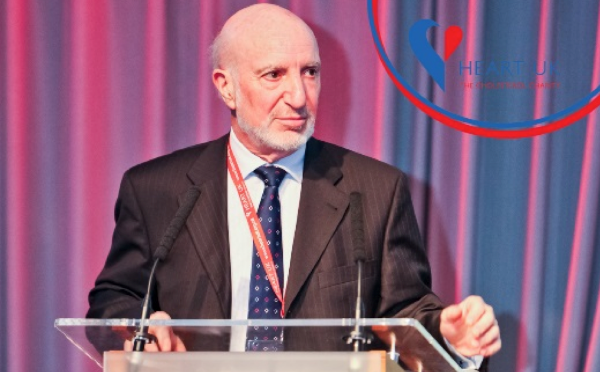‘Cholesterol – the evolving story’ was the theme of this year’s HEART UK conference, covering primary and secondary care, patients and industry. The event was held at the Edinburgh Conference Centre from 6th–8th July 2016. General Practice Nurse Jaqui Walker reports some of its highlights.
 The first day of the conference focused on hyperlipidaemia in children. In the opening address Professor Albert Wiegman (University of Amsterdam, The Netherlands) presented compelling data on the importance of screening and identifying children with familial hypercholesterolaemia (FH) so they can be effectively treated and early cardiovascular events prevented.
The first day of the conference focused on hyperlipidaemia in children. In the opening address Professor Albert Wiegman (University of Amsterdam, The Netherlands) presented compelling data on the importance of screening and identifying children with familial hypercholesterolaemia (FH) so they can be effectively treated and early cardiovascular events prevented.

FH is one of the most common genetic disorders in the world. Both heterozygous, and to a greater extent homozygous FH, can be disabling at a young age and shorten life expectancy. Homozygous familial hypercholesterolaemia (HoFH) should be treated as soon as it is diagnosed.
He described heterozygous, FH in childhood as not just a disease or a disorder but a disaster! It causes a 100-fold increase in relative risk of a coronary event in the 20–40 year age group. Help is at hand, however, and treatment of childhood FH with pravastatin has been shown to be safe and effective.1
The impact of circadian rhythms and sleep on diet-related cardiovascular risk?

Professor Bruce Griffin (Department of Nutritional Sciences, University of Surrey, Guildford) explained that circadian rhythms exist to help survival in a 24-hour light/dark cycle. As well as a master circadian clock, peripheral clocks exist throughout the body, which impact on metabolic functions, hunger and hormones. External cues such as meal timing, physical activity and sleep-wake cycles help synchronise the control of the digestion of food, the storage and utilisation of food energy and overall energy balance.2 Modern work and social life can disrupt this system by creating a mismatch between these cues and endogenous circadian rhythms. This ‘chronodisruption’ is implicated in the development of obesity and increased cardiovascular risk.3 The situation can be complicated by an individual’s naturally occurring preference for morning or evening being misaligned with externally entrained rhythms.
In order to prevent ‘chronodisruption’ individuals should avoid irregular meals and sleep deprivation which increases appetite and inappropriate dietary choices. Consuming more of the energy earlier in the day4 and intermittent fasting5 are also effective in promoting weight loss and reducing cardiovascular risk. It is possible that some people only get back into their true rhythm at retirement.
A historical perspective
Professor Paul Durrington (University of Manchester, Cardiovascular Research Group, Manchester), provided a fascinating journey, drawing on examples from art and medical literature, to the roots of our cholesterol knowledge. Starting as far back as 474 BC, then journeying through the 1517 Mona Lisa, and seminal trials such as 4S, WOSCOPS, CARDS, etc… key people, studies, controversies and discoveries were all described and an amazing perspective given. He highlighted the great advances in our understanding of hypercholesterolaemia achieved in recent years. Professor Durrington described nutrition as the basis of atherosclerosis. He also cautioned that the UK lacked the expert clinicians and scientists required to translate science into medical practice but praised HEART UK, describing its work as critical for future development.
The changing face of cardiovascular risk in the UK
 Professor James Shepherd (University of Glasgow, Glasgow, Scotland) credited improved drug therapy and better management of risk factors as the main reasons for the reduction of cardiovascular disease (CVD) in the UK. He described statins as essentially universally beneficial and effective in preventing CVD in men and women, at all ages, irrespective of individual risk, in diabetics, people with hypertension, smokers and in all arterial beds, coronary, cerebral and peripheral.
Professor James Shepherd (University of Glasgow, Glasgow, Scotland) credited improved drug therapy and better management of risk factors as the main reasons for the reduction of cardiovascular disease (CVD) in the UK. He described statins as essentially universally beneficial and effective in preventing CVD in men and women, at all ages, irrespective of individual risk, in diabetics, people with hypertension, smokers and in all arterial beds, coronary, cerebral and peripheral.
Evidence gained from reanalysing the TNT trial data suggest that by retarding the progression of atheroma in the coronary tree you also prevent the worsening of congestive heart failure, the need for revascularisation by improving cardiac output and this improvement in cardiac output also retards any further decrease in renal function.6,7 Therefore aggressive cholesterol lowering with statins makes good clinical sense, as long as this does not generate side effects and it may confer additional health benefits.
A view from general practice
Dr Bob Finnie a retired GP from Edinburgh explained how general practice including lipid management has changed beyond recognition since 1986. 30 years ago triglycerides, HDL-C and LDL-C were unknown to most GPs, a cholesterol test was seldom performed and statins were not available.
Lipid management in general practice has however not been free from scepticism, confusion and a lack of clear non-conflicting guidance. Confusion around targets, risk, types of cholesterol, fasted or non-fasted blood tests, has been problematic. The introduction of QOF in 2004 changed lipid management dramatically with an exponential rise in statin prescribing. Awareness of familial hyperlipidaemia has increased aided by HEART UK, SHARP in Scotland and postgraduate education.
The key for the future is for GPs to discuss with patients how many drugs they are happy to take and how low they aim to get their cholesterol.
The patients’ perspective
Mrs Yvonne Dumsday and Mrs Hazel Gallagher explained how FH had affected them, their families and their lives including the positives such as their work with what is now HEART UK.
Yvonne Dumsday found out about FH by chance when listening to a radio programme and explained how her mission since then had become to make sure that 25 years later everyone knew about FH in the same way they understand multiple sclerosis (MS). She regrets that despite the fact it may affect 1 in 250 people this has not yet been achieved. Mrs Dumsday stressed the importance of the patient voice being heard and ensuring they have access to meetings such as this HEART UK conference.
Mrs Hazel Gallagher found when she was diagnosed that there was no information available for families with FH. Together with Carolyn Bradbeer she founded the Familial Hypercholesterolaemia Association (FHA) which later joined with the British Hyperlipidaemia Association (BHA) to become HEART UK. Mrs Gallagher described lack of FH awareness as more dangerous than the condition itself, and put this into the context of her uncle who died at 40 with FH and whose sons both developed heart disease in their 30s. Mrs Gallagher and her sons who have FH are healthy, manage their condition and live life to the full.
The Myant Lecture LDL and atherosclerosis

Professor Chris Packard (University of Glasgow, College of Medical, Veterinary and Life Sciences, Glasgow, Scotland, UK) described a convergence of information from epidemiology, pathology, genetics and clinical trials as having identified the key role of LDL-C in atherosclerosis. LDL is a causative and essential factor in atherosclerosis, as opposed to other factors such as raised blood pressure or smoking which are aggravating factors.
20 years of follow up from WOSCOPS shows a legacy benefit from the original five years of statin intervention in the active arm of the trial. With no difference in adverse events, coronary mortality was reduced by 27%, all-cause mortality by 13% and heart failure by 31% in the pravastatin arm as opposed to placebo. The mechanism for this may be due to a resolution of precursor fatty steaks in the arteries and thus modification of the natural history of disease.
The HDL hypothesis based mainly on the consistency of epidemiology data has not been supported by genomic or clinical trial outcomes. With the emergence of new treatments, such as the PCSK9 inhibitors, the focus has returned to LDL. We need to consider in the future how treatment paradigms can include all treatment options and be both efficacious and cost effective.
In reviewing the outcome of clinical trials Professor Packard proposed that in order to resolve atherosclerosis LDL-C should be reduced to about 1.0 mmol/l. This is the level people are born with, and in populations with LDL-C in this range there is no coronary heart disease.
Areas for future development include troponin I in asymptomatic subjects as a measure of micro damage. Treating LDL turns people from net rupturers into net repairers of atheromatous lesions. These intermediate markers can inform therapy as we move forwards. Triglycerides are also likely to create further interest.
He called on the audience to “follow the data and not the herd, and we will get there in the end.”
Dietary fats and cholesterol
Professor Bruce Griffin (Department of Nutritional Sciences, University of Surrey, Guildford, UK) explained how the association between nutrients and CVD risk found in prospective cohort studies has not been upheld in randomised controlled intervention trials. This may be because the relationship between saturated fat and CVD is not direct but relies heavily on the ability of certain saturated fats to raise LDL-C. The cardio-metabolic risk with fats is linked to the accumulation of visceral fat, having a fatty liver and vascular dysfunction.
For most people there is no need to restrict dietary cholesterol, UK, European and USA guidance now supports this. Certain groups however, e.g. those with FH, will need to watch their dietary cholesterol. What you substitute saturated fat with is important.
We need food-based, not macronutrient, guidelines. It is important to consider the foods consumed, e.g. plant and dairy sources of saturated fat appear better for cardiovascular health than refined meat sources. Long chain omega-3 fatty acids have proven benefits in reducing cardio metabolic risk but they should be consumed from whole fish and not supplements.
The Scientific Advisory Committee on Nutrition SACN has formed a Saturated Fat Working party and is due to report its findings in 2017–18.
Therapeutics – what does the future hold?
Dr Kees Hovingh (VU University Medical Center, Amsterdam, The Netherlands) looked at the options for patients who fail to achieve acceptable LDL-C levels with the currently available lipid lowering drugs. PCSK9 has emerged as a promising target and the speed and scale of development from discovery to treatment has been unprecedented. There are now three PCSK9 inhibitors in clinical outcome trials which aim to establish their clinical efficacy in terms of CVD reduction, safety, and the consequences of prolonged exposure to very low levels of LDL-cholesterol. The outcome data are expected by the beginning of 2017 and there is no signal to date that the very low LDL-C levels achieved with these drugs are a problem in terms of adverse events.
Other therapies include those that have an effect on triglycerides (antisense therapy) and treatments that reduce inflammation in the artery wall. Data is needed to show the effect this has on CVD.
He concluded that statins and ezetimibe remain first choice but adding other drugs to further reduce residual risk will be important in the future.
100,000 Genomes Project

Professor William Newman (Manchester Centre for Genomic Medicine, University of Manchester) described how the 100,000 Genomes Project was initiated about four years ago by the NHS, as it became clear that new types of genomic technology would be important in diagnosing conditions and planning treatment in the future. There are three main sections to the programme: rare diseases, cancer and infectious diseases. By sequencing the whole genome it will be easier to go back and pull off additional data in the future and variants such as duplications and deletions can be looked at across the whole genome. Data can be shared nationally and internationally to help increase understanding.
Professor Newman called upon the audience to consider patients who had already undergone genetic testing but for whom a genetic diagnosis had not been established and to approach the 100,000 genomes project. This will be particularly useful in FH as a number of patients have genetic tests without a causative mutation being found.
The interpretation of the tests was explained with certain key genes being checked for and then a Genome Clinical Interpretation partnership GeCIP being used to get expert help where findings are less clear. The audience was asked to consider membership of this partnership. It is hoped that by sharing data, new genes will be discovered.
The 100,000 Genomes Project gives patients the option to proactively seek additional information about certain cancers and FH and their carrier status of certain conditions if they plan to have children.
There is a big drive to help the general public and healthcare professionals understand more about genomics, with a massive open online course on genomics as well as Health Education England (HEE) funded courses.
Tackling obesity
Dr Justin Rochford (Rowett Institute of Nutrition and Health, University of Aberdeen, Scotland, UK) described the future of obesity management with therapies that can alter appetite, nutrient storage or energy expenditure. This is likely to include pharmacological approaches but also specific changes to diet or working with the food industry in the development of foods high in nutrients and with a capacity to alter metabolism and body weight. The gut flora is an interesting area of investigation and some superfoods such as blueberries are showing promising anti-obesity effects.
References
1. Wiegman A, Hutten BA, de Groot E, et al. Efficacy and safety of statin therapy in children with familial hypercholesterolemia: a randomised controlled trial. J Am Med Assoc 2004;292:331–7.
2. Mattson MP, Allison DB, Fontana LM, et al. Meal frequency and timing in health and disease. Proc Natl Acad Sci USA 2014;111:16647–53. http://dx.doi.org/10.1073/pnas.1413965111
3. Scheer FA, Hilton MF, Mantzoros CS, Shea SA. Adverse metabolic and cardiovascular consequences of circadian misalignment. Proc Natl Acad Sci USA 2009;106:4453–8. http://dx.doi.org/10.1073/pnas.0808180106
4. Garaulet M, Gómez-Abellán P, Alburquerque-Béjar JJ, Lee YC, Ordovás JM, Scheer FA. Timing of food intake predicts weight loss effectiveness. Int J Obes 2013;37:604–11. http://dx.doi.org/10.1038/ijo.2012.229
5. Varady KA, Bhutani S, Klempel MC, et al. Alternate day fasting for weight loss in normal weight and overweight subjects: a randomized controlled trial. Nutrition Journal 2013;12:146. http://dx.doi.org/10.1186/1475-2891-12-146
6. Shepherd J, Kastelein JJ, Bittner V, et al. Effect of intensive lipid lowering with atorvastatin on renal function in patients with coronary heart disease: the Treating to New Targets (TNT) study. Clin J Am Soc Nephrol 2007;2:1131–9.
7. Parikh S, Shrank WH, Mogun H, Choudhry NK. Statin utilization in nursing home patients after cardiac hospitalization. J Gen Intern Med 2010;25:1293–9. http://dx.doi.org/10.1007/s11606-010-1473-z
